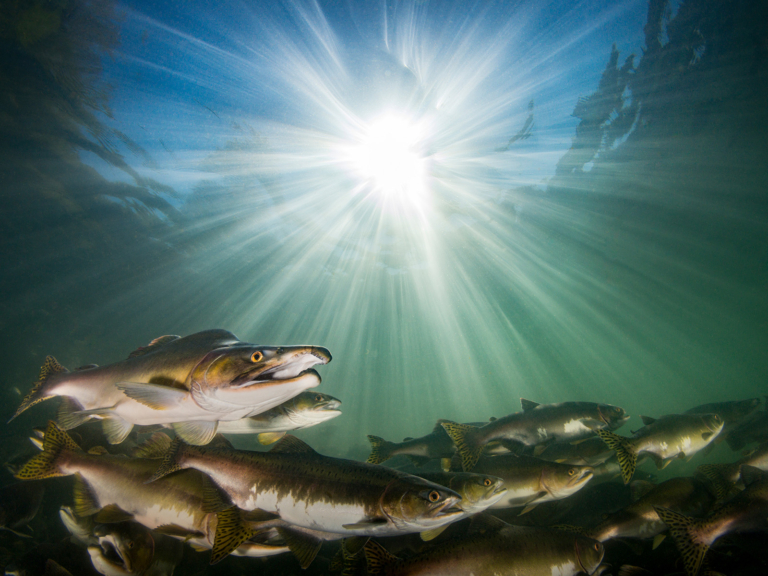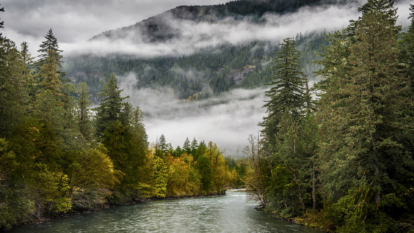Suing for Survival
Do Skagit River salmon have legal rights?
Listen to the story
What happens when a fish takes the witness stand in a courtroom? The seat probably isn’t very comfortable, and the fish might not be able to see the jury.
During a recent lawsuit in Washington state, salmon had a little help from their allies, the Sauk-Suiattle Indian Tribe, who argued “Sahkuméhu (the Sauk-Suiattle) have a sacred covenant with Tsuladxʷ’s (salmon) and the Stulekʷ (river) and all living creatures without which we cannot live.” Employing the “rights of nature” legal strategy, the Tribe sought acknowledgement that three Skagit River dams owned by Seattle City Light infringed upon the fish’s “inherent rights to exist, flourish, regenerate … and the right of access to their ancestral waters.”
The Skagit River in Washington has long connected every living thing within the region. With its headwaters in British Columbia, the river runs 150 miles through the heart of the rugged Cascade Range as it provides 30 percent of the fresh water that flows into Puget Sound. It’s the region’s only river that is home to every native salmon and trout species, including endangered Puget Sound Chinook, bull trout and steelhead. And, thanks to those three hydroelectric dams at the center of the lawsuit, it produces 20 percent of Seattle’s electricity. But the dams don’t just generate power—they prevent salmon from reaching indispensable spawning habitat.
Salmon runs up and down the Pacific Coast have continued to dwindle for more than 100 years, despite decades of restoration efforts, many of them futile. The future of these fish still hangs on each egg they lay. As a keystone species of the Salish Sea, they are vital to the region’s ecosystem. Chinook are the preferred diet of Southern Resident orcas, another beloved and endangered species of the region. Salmon feed bears and eagles; when the fish die, nutrients from their carcasses nourish the rivers and fertilize the forests. The whole process is so complex, ingenious and beautiful that it could have only been devised over millennia by the mind of Mother Nature herself.
While Seattle prides itself on implementing progressive policy actions to build a sustainable future, the city’s publicly owned utility company, Seattle City Light, remains an alarming and infuriating contradiction. The company’s “clean” power comes at the expense of the region’s most iconic fish and traditional Coast Salish culture. “In the grand scheme of things, that’s what we see as at risk here—a way of life—our way of life,” said Nino Maltos II, chairman of the tribal council for the Sauk-Suiattle Indian Tribe. “If these salmon were to go extinct, it would destroy generations of future teachings that are long to come. It would change everything.”
In early 2022, it was time for fish to take the stand. The Sauk-Suiattle Indian Tribe sued the city of Seattle on behalf of the salmon. Filed in Tribal court for Tsuladxʷ (the Lushootseed word for salmon), the suit declared that “… tribal members possess a right and a public trust … to protect and save Tsuladxʷ, and protect the waters that support Tsuladxʷ … free of obstructions which interfere with their right to exist.” Seattle City Light’s three Skagit River Hydroelectric Project dams were built without the consent of local Indigenous communities, the suit noted, and completely block fish passage. “The river’s been taking care of [the city],” Maltos said in January 2023. “We think it’s their time to take care of the river.”

Pink salmon are the smallest but most abundant of the five Pacific salmon species. As they charge up their natal streams to spawn, the males develop a prominent dorsal protrusion, inflicting them with their slightly awkward nickname—“humpies.” Photo: Eiko Jones
Rights of nature legal strategies, such as the Sauk-Suiattle’s lawsuit, are based on a concept whereby legal standing is secured for elements of the natural world—a river, a species or an ecosystem. In 2008, Ecuador added a provision to its constitution protecting the rights of nature. New Zealand, in 2017, officially recognized the legal rights of the “physical and metaphysical elements” of the Whanganui River. In the years since, the movement has gained traction. In late 2022, Port Townsend and Gig Harbor, Washington, put forward proclamations recognizing the rights of Southern Resident orcas, who depend on salmon as their primary food source. According to the Center for Democratic and Environmental Rights, more than three dozen tribal and local governments within the United States now have laws protecting the rights of nature.
The Skagit and its headwaters have been home to Coast Salish tribes and salmon since time immemorial. After countless generations of flourishing coexistence, colonialism brought devastating changes. In the mid-1800s, Washington state’s then-governor Isaac Stevens signed numerous treaties with the region’s Indigenous tribes exchanging land for the promise of tribal sovereignty, protection and the continued right to hunt and fish on their ancestral grounds. The state cynically overlooked these agreements. More than 100 years of subjugation, harassment and the struggle for treaty-guaranteed fishing rights culminated in numerous protests throughout the late 1960s and early ’70s.
The federal government sued the state of Washington over the issue. The 1974 ruling, known as the “Boldt Decision,” affirmed that the treaties allocated tribes half the available catch of all fish and established tribes as co-managers of the state’s dwindling fisheries. Along with the Sauk-Suiattle, the Swinomish Indian Tribal Community, and Upper Skagit Indian Tribe also call the Skagit watershed home. All three federally recognized tribes have distinct management practices, which, in conjunction with local entities, can make for contentious policy making.
“In the grand scheme of things, that’s what we see as at risk here—a way of life—our way of life.”
The Sauk-Suiattle lawsuit was filed as the city looked to renew its federal license to operate the dams, which expires in 2025. New licensing agreements are typically all but guaranteed and last anywhere from 30 to 50 years. But this moment caught the public’s attention. The process brought newfound scrutiny to Seattle City Light’s environmental policies thanks to the suit’s rights of nature tactic and the region’s deep ties to salmon. “Our action is a mix of having a legal basis, but also, because it’s a public process, to cause change through public knowledge—to bring to bear upon the company,” said Jack Fiander, the Tribe’s lawyer.
It was worth a try.
Nine days before the April 28 deadline for the license renewal, Seattle City Light announced the inclusion of a fish passage program in its final license application, which led to the settlement of the lawsuit. The proposed “trap-and-haul” program will truck fish around all three dams, but could take up to 20 years to fully implement. While this does not solve the ongoing crisis salmon face on the Skagit, establishing fish passage around the dams has been a primary concern for the Sauk-Suiattle.
According to Chris Townsend, director of natural resources and hydro licensing at Seattle City Light, one reason for the inclusion of the fish passage program is, “to contribute to the recovery of fish given changing climate conditions and habitat availability in the lower river … it could be an important part in maintaining populations in the future. [Another] is to create harvestable fish for the tribes downriver.”
“Resolving [the lawsuit] in such a way that the tribe was able to protect the salmon, even if it’s through a settlement or by agreement … makes future cases involving truly advocating for rights of nature easier to present,” Fiander said.
Considering this was only the second rights of nature case to be brought in the United States, the movement is still nascent and working to establish legal precedent. And even if there was no ruling, the idea continues to move from local grassroots initiatives and tribal communities toward the state and federal levels. While the settlement is to the benefit of the Skagit River and salmon, three uncompromising, human-constructed cement problems remain. Throughout the relicensing process, calls to remove even the lowest dam had little resonance. Even if the Skagit River Hydroelectric Project’s dams won’t be coming down anytime soon, the Sauk-Suiattle’s lawsuit is, hopefully, a small crack in the system, one that can propagate throughout the entire watershed of river reclamation.
“Not only have [the Sauk-Suiattle] had really practical outcomes from this case, but they’ve also been able to demonstrate what is possible and how to do it,” said Mari Margil, executive director for the Center for Democratic and Environmental Rights. “That is all quite important in developing rights of nature laws, but also just helping other tribes and even non-Indigenous communities to say, ‘OK, now we can see the path.’”
Interested in more activism stories?
Don’t miss the latest environmental stories, action alerts and other ways you can help save our home planet. Join us at Patagonia Action Works today.

